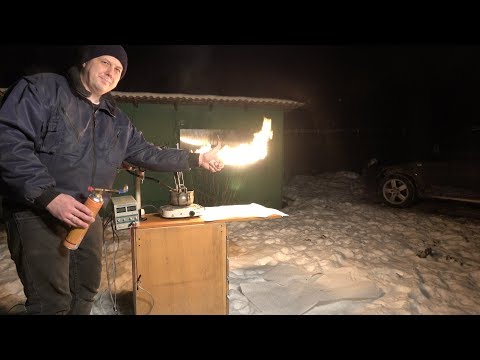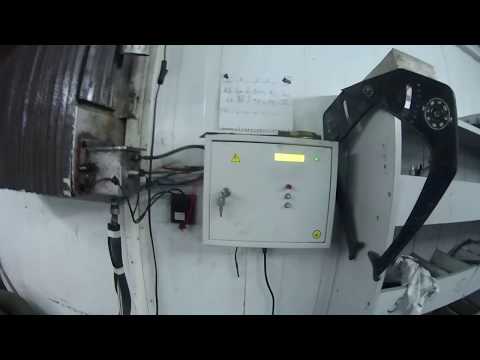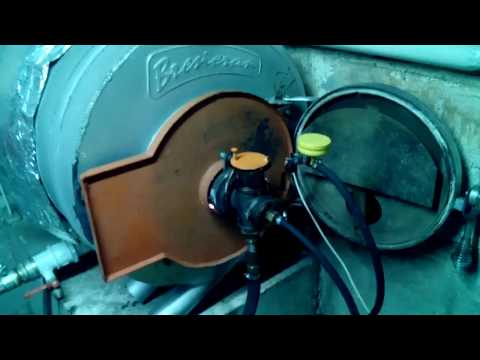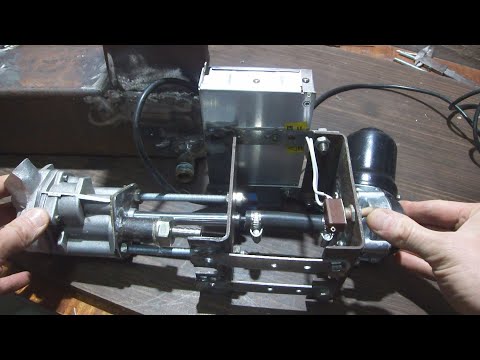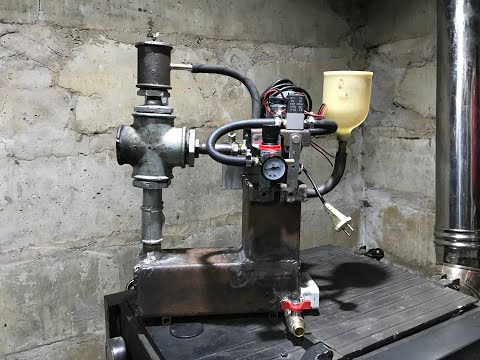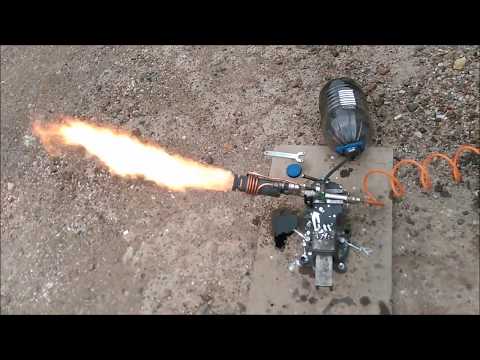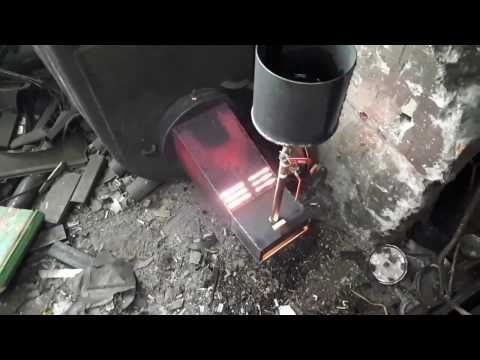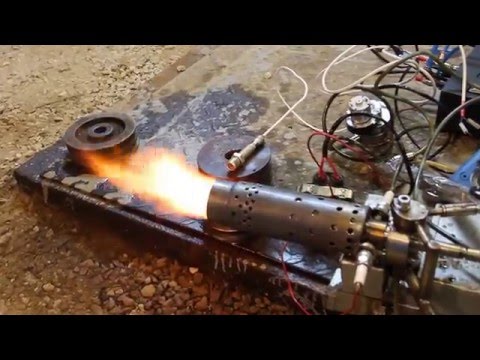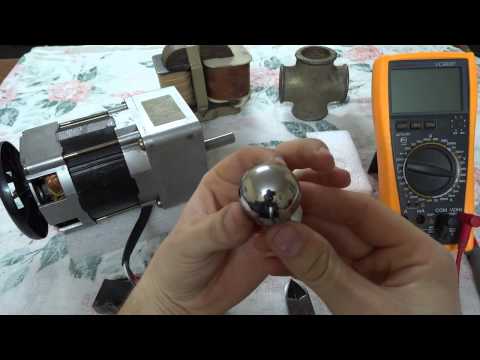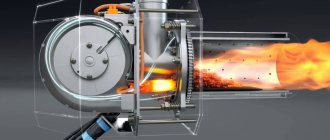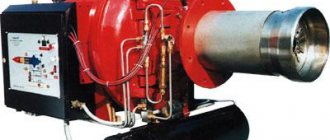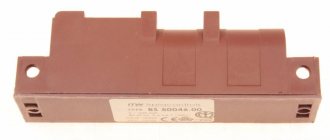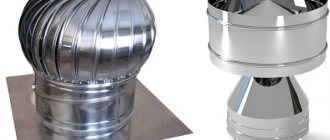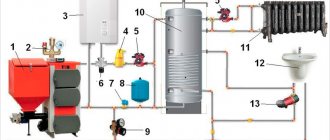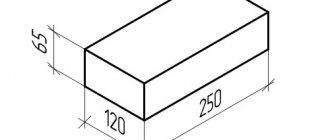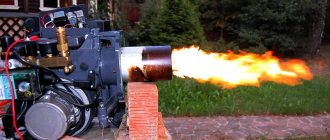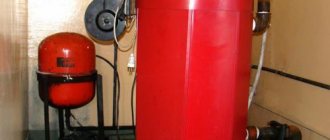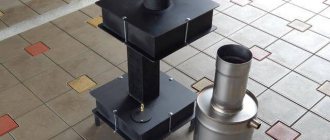Upon closer examination, it turns out that the proprietary equipment for dirty and unstable quality liquid fuel is expensive and somewhat capricious. In this case, the craftsmen are rescued by Babington burners. The design is not critical. Self-made samples are workable. But most importantly, the Babington burner makes it possible to achieve the main goal - to save as much as possible on the most expensive communal apartment - on heating.
Why Choose Babington Burner
Used oil is difficult to dispose of, and some organizations do not know how to dispose of it. Meanwhile, it is an excellent energy carrier, with an average heating value of 1 kW / liter, i.e. at the level of diesel fuel and gasoline. It is extremely profitable to drown the labor service, if it is obtained free of charge. How much money is spent on heating a private house? ... It is enough to get 5 tons of shareware mining and ... But the problem remains to burn it.
- The advantage is that the Babington burner can run on the most contaminated liquid fuels. The quality can change even in the process of direct combustion, while energy efficiency can decrease, but the operation of the device remains stable.
- The second advantage is that the composition of the fuel mixture is not regulated. In a normal design, combustion always occurs with an excess of air (oxygen), everything that can ignite burns out.
- Maintenance of the combustion zone is extremely simple or not required, that is, the burner, the nozzle does not fail due to exposure to the flame - the technique is relatively reliable.
How is this achieved in design?
Disadvantages of a simple burner for working off
- The Babington burner contains an air compressor, and often an oil pump (why not be discussed below). This requires power and maintenance. Therefore, the burner is volatile and also with some probability of technical breakdown.
- The second drawback is that the burner operates at a constant power, which is incorporated into its design. Power can be changed stepwise, changing structural elements (if any), but these are too rough and large values, for example - 22, 35, 57, 70 kW. In fact, the device can only work in the "warmed up - stopped" mode, but you need to turn it on manually ....
- It is possible to light a homemade Babington burner only from some kind of torch or blowtorch. It is necessary to apply a flame to the area of the combustible mixture of oil and air in order to ignite it. Every time you need to turn on the heating, you need to visit a dirty furnace. And also to turn it off. But why is everything dirty?
- The entire fuel system with open oil tanks, with possible manual oil supply, implies the presence of oil vapors, odors, spills. It is unacceptable that doors from such an aggregate workshop lead directly into the house. Therefore, the room with the installed Bangbinton burner and the boiler on which it can work is specially prepared separately, and it also creates the possibility of mechanical pumping of waste from storage tanks.
The principle of operation of the Babington burner - what is the secret
The principle of operation of a burner for burning oil is the formation of an air stream that hits the stream of liquid and sprays it. The mixing of oxygen and oil takes place directly in the combustion chamber.
But the main secret of the Babington burner - the special uniformity of the fuel supply to the combustion zone under the influence of two forces - surface tension and gravity - does not depend on the operation of any mechanisms. The fuel simply flows down the metal surface.
Hence the main advantage - the ability to burn contaminated mixtures. There are no bottlenecks on the way of fuel movement, it is fed through wide tubes and then falls on the surface which flows around….
Design features
At the heart of the design is a hemisphere (ball) along which fuel flows in a wide stream from top to bottom. The hemisphere has a very narrow opening through which an air jet is supplied. Air sprays oil on its way, forming a stream of finely dispersed mixture, which ignites and burns safely.
Air is supplied to the hemisphere under low pressure (up to 0.5 atm) by a compressor, and oil flows out of the tube - pressure equalizer (the same level with overflow). But the viscosity of the oil should not be high and stable. To do this, it is heated in a copper tube, which wraps around the burner in 2 - 3 turns, which stabilizes the thickness of the flow on the hemisphere, and hence the combustion power.
How to make a burner with your own hands according to diagrams and drawings
The burners obtained on the basis of the invention of Robert Babington have undergone numerous revisions and upgrades. Hence the discrepancies in different drawings, diagrams and illustrations. The chosen option needs to be carefully studied in order to exclude constructive errors.
Burner assembly diagram, where 1 - fuel intake; 2 - fuel pump; 3 - fuel filter; 4 - burner; 5 - compressor; 6 - air compressor hose; 7 - fuel hose; 8 - fuel line
Tips and tricks from other craftsmen can also be useful for making certain elements and nodes. The suggested explanations, which are taken from one of the specialized forums, deal with the following details:
- a metal hemisphere (can be made from anything, including a piece of a brass doorknob or a spherical nut);
- a steel threaded tee for connecting two-inch pipes (instead of it, you can take a cross with the same parameters);
- 10mm copper tube is suitable for fuel supply;
- for the nozzle, you need a squeeze of a metal pipe with an external thread (up to 200 mm);
- a metal tube with a diameter of 10 mm, supplied to the nozzle, is useful for air supply;
- it is better to dock the channels with the body with threaded fittings of a suitable size;
- the main flow of mining will be carried out by a small pump with a simple motor (from a motorcycle or car).
To avoid mistakes when assembling the burner, it is necessary to carefully study the instructions and diagrams.
The nozzle is a small hole, its size adjusts the power of the homemade product according to the principle of R. Babington. Sometimes several small holes are made in the hemisphere, since one may become clogged or not enough. There is information that 1 hole 0.25 mm in size will provide a burner power in the range of 10-15 kW, which depends on the quality of the raw material being combusted.
In a hemisphere with a finished hole, an air supply channel is fixed through the entrance through the tee. The tightness is ensured by the threaded plug, in which the groove for the tube is drilled. The tee should be soldered to the nipple where the oil supply tube is connected, which requires warming up before disposal. To do this, it is necessary to solder the heating element into the tank, preferably with a thermal relay. A tube in several turns will prepare the oil for feeding into the nozzle.
In order for air to flow, in addition, 2 grooves of about 8 mm in size must be drilled in the nozzle. First, a nozzle is connected to the tee, then a copper spiral tube, after which it is attached to the fitting. Some of the oil will drain into a settling tank, which for safety is best taken to the side through a pipe. Craftsmen who know the secrets of electronics usually equip the apparatus with a controller and a board for organizing the ignition.
The burner is a versatile design that can be adapted to other types of liquid fuel. Although these devices are commercially available today, their high cost encourages DIYers to do something similar with their own hands.In terms of efficiency, household appliances for burning mining are not inferior to brand new products designed for heating mini-workshops, greenhouses, and small farms.
Manufacturing recommendations
Due to its popularity and simplicity, a burner for a boiler is being manufactured by craftsmen in different variations, but we will undertake to describe the simplest design that will be available for repetition at home. First you need to select the necessary materials, here is a list of them:
- Steel tee with 50 mm female threads - for body.
- Squeegee with an external thread with a diameter of 50 mm - for a nozzle. Its length is taken at will, but not less than 100 mm - for the nozzle.
- Elbow made of DU10 metal with external threads - for connecting the fuel line.
- Copper tube DN10 of the required length, but not less than 1 m - for the fuel line.
- Metal ball or hemisphere, freely entering the tee - for the working part.
- Steel tube not less than DN10 - for connecting the air duct.
To make a burner for testing with your own hands, you need to perform one precise operation - make a hole in the center of the sphere. The hole diameter is 0.1 to 0.4 mm, the ideal is 0.25 mm. It can be done in 2 ways: drill with a tool of the appropriate diameter or set the finished nozzle to 0.25 mm.
Making such a small hole exactly is not easy; thin drills break easily. Instructions on how to do this correctly are shown below:
Another way to make a calibrated hole in the spherical part of a self-contained burner is to insert a nozzle of the required diameter there. For this, a hole is drilled, whose diameter is slightly less than the outer diameter of the jet, and processed with a reamer. The jet is pressed inside and polished, as described in the video:
When this operation is completed, we assemble the burner, based on the drawing:
On the side of the nozzle, a hole must be made wide enough to ignite the unit. The fuel heating spiral does not need a large one, 2-3 turns are enough. The finished product can be fixed on a mounting plate and built into any boiler, including homemade ones. At the end of the work, you need to connect the air and fuel lines, and then arrange the oil and air supply. The simplest way of fuel supply is by gravity, for this, the container with the mining is suspended from the wall above the burner and a tube is laid from it.
If you use a pump to pump oil, then you can later use the control sensors and the control unit, then you will have an automatic burner that will be safer to operate. Detailed instructions for the selection of materials and assembly of the device are shown in the video:
If everything is done correctly and the diameter of the air hole is 0.25 mm, then the fuel consumption of the burner should not exceed 1 liter per hour. There should be no black soot during combustion, you need to achieve even burning of the torch. Adjustment is made by moving the sphere back and forth or by changing the air pressure. Any compressor can handle it, even from a refrigerator, since the operating pressure does not exceed 4 bar.
We do it with our own hands
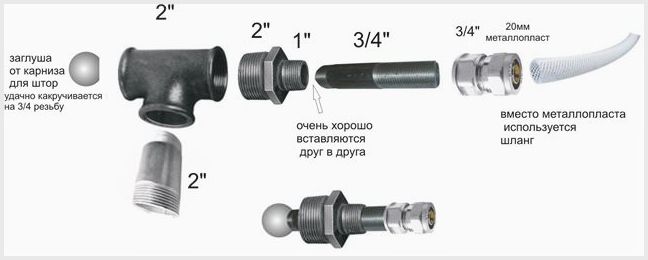
The manufacturing process of the Babington burner is not easy enough and if there is all the materials that will be needed and the tools it takes only a couple of days, depending on the ability of the person.
For the production of this device, you will need the following materials:
- tube made of DU10 steel,
- iron tee with a diameter of 50 millimeters with an internal thread;
- an iron sphere (or hemisphere) with a diameter less than 50 millimeters;
- copper tube DU10 not less than 1 meter in length;
- metal elbow DU10 with external thread;
- a piece of pipe with a diameter of 50 millimeters with an external thread, at least 10 centimeters long;
You will also need a very small toolkit:
- angle grinder (angle grinder) or hacksaw for metal;
- puncher;
- specialized chuck for thin drills;
- drill;
- drill with a diameter of 0.1–0.3 millimeters;
- soldering machine;
Preliminary stage
at the beginning of the assembly, you need to make a hole in the area (hemisphere). This is one of the most difficult and serious stages, since the hole must be made exactly on the inside. Otherwise, the torch of the burner will be directed to the side, which, in turn, may have a bad effect on the quality of the product and on its economy.
It should also be said that drilling holes of this diameter is not an easy task, since thin drills can break. Thanks to this, this process must be done carefully and leisurely.
detailed instructions
After the sphere or hemisphere is ready, you can start assembling. It is quite simple and has a few simple steps:
- The iron section of the pipe will act as a nozzle. It is cut to the required length and twisted into a tee. After that, a very large hole is drilled in the pipe section from the side, so that a stream can be ignited through it.
- Top of the tee closer to the nozzle, a hole is made for a copper tube, through which fuel will be supplied to the device.
- To the copper tube an elbow is attached to connect the fuel line.
- Copper tube several turns are performed (2-3 is quite enough) around the nozzle. They must be done at a certain distance from the pipe segment. This will enable the oil to be heated to the required temperature before it enters the sphere.
- In the area at the opposite end of the small hole another one is drilled along the outer diameter of the steel tube. The tube is sealed into the sphere. This is necessary so that the air comes out only through a small hole, and pressure is created in the middle of it. If a hemisphere is used to replace the sphere, then the tube is soldered in the place of the small hole and sealed.
- From the opposite end of the nozzle an iron tube with a sphere is placed in the tee. It is attached to it.
- Likewise, the burner is ready for use. It remains only to attach an air blower to the tube with the sphere, which will aggravate the air and the fuel line to the copper tube into it.
- If there is a desire this system can be improved by connecting a pump for oil supply. It is also possible to install the control unit control sensors. This will make this system automatic and safest.
Waste oil burners
The principle of operation of traditional oil burners is almost the same, they differ only in design features, level of automation, power and efficiency.
There are modified types of burners:
- burners with pre-gasification of fuel;
- evaporative burners.
Some oil burners combine all the elements in their design: pump, filter, heating chamber and compressor. Such models save space and do not require the installation of additional equipment.
All burners can be divided according to the operating mode:
- single-stage burners can only work in one mode;
- two-stage are capable of operating at 40% of their power and at 100%, that is, they have 2 modes;
- modulating burners operate in a wide power range: from 10 to 100%.
Principle of operation of waste oil burners
Oil burners are also called injectors. Their work is based on the principle of injection. That is, a strong air flow is created through the nozzle and a vacuum is formed in the fuel supply line, due to which oil flows into the combustion chamber and mixes it with air.
The efficient combustion of any liquid fuel depends on the intensity of its atomization.And the efficiency of atomization depends on the special design of the nozzle and the force of the compressed air pressure.
Fuel preparation
Before entering the burner, the fuel is filtered in a fuel filter and preheated in a special chamber. This is necessary to reduce the viscosity of the oil. For burning of mines, preheating is 80-900C. Fuel preheating temperature control is carried out automatically.


Diesel fuel does not need to be preheated as it has sufficient fluidity.
Fuel supply
Fuel from the tank is pumped out by the fuel pump. Its intake is carried out from the surface of the mirror of the flammable liquid. This is due to the fact that mining may have mechanical impurities or water that settle at the bottom of the tank.


Combustion process
To maintain the combustion process, a certain amount of oxygen must be present in the combustion chamber. The air that is used for rarefaction and fuel supply is called primary air, and it supports the combustion process, but this is not enough.
An additional fan supplies secondary air. The intensity of the fan is regulated by a damper and participates in the operation of the automation system.
Fuel ignition
For the automatic ignition of a liquid fuel boiler, an ignition transformer and electrodes are used. The fuel is mixed with a jet of air and atomized into small droplets. Then it is fed into the combustion chamber and ignites under the influence of high temperature.
Video on the topic
# 1 professor
winner 2008: best Manta
- Our users
- Posts: 809
- Gender: Male
- Interests: Everything related to OPEL MANTA!
- Car: opel manta
- Real name: Ivan
- Place of residence: City of Yeysk. Krasnodar Territory
I actually decided to open the topic. In our cold time, I think it is quite important to heat garages. boxes. houses. The device and the principle of operation can be viewed on YouTube. https: //www.forumhous. / threads / 84957 / true babington men gather here https://lunohodov.net. t. asc & start = 0 Here the photo shows a very primitive burner device.
The burner itself was invented in the 60s in America. the patent was recently withdrawn. the drawings were in the public domain. I assembled such a burner myself. 1. oil supply. very important! consists of a reservoir. oil pump (vaz.gaz.mot ural.i.d.) in my case it is a gas 402 motor .. fell with a broken drive. electric gearbox. can be with a vase. but better with a foreign car. they are more powerful. Power Supply. for us in our case, 5 volts is enough for the gearbox. a block was taken from a computer of 450 watts. we close the green with a black wire in the center of the block (green is the only one there), we throw it on the yellow-black (12 volts) or on the red-black (5 volts) load. any. then we turn it on. without load, the unit will fail after being turned on. Depulsator is a device for smoothing the oil supply from the pump. Consists of a small cylindrical reservoir with a volume of 50 grams with an upper oil supply into it. return flow in the middle and fuel supply to the burner. automatic tena .. there are a lot of them on sale. any with a temperature controller.
Completion of manufacturing
The burner will have a powerful flame, but for smooth operation it is important that all designs of external elements are thought out correctly. In the considered variant, the mining flows down the sprayer in the form of a sphere, but most of it returns back to the tank, a small amount enters the nozzle
To increase efficiency, it is recommended to install at least a weak heating element in the main tank. If you do not want to manually transfer oil from one tank to another, you need to install a small pump. It is installed between the tanks and allows you to pump oil from one to another, thereby ensuring the circulation.


To increase the service life of the unit, it is recommended to treat the joints with high-temperature sealants.It is recommended to put a thermostat on the heating element (if such is not provided). It is enough to warm the oil to a temperature of 70 degrees, it makes no more sense. As a result, you should have three nodes consuming energy. These include:
- Compressor.
- Oil pump.
- A heating element.
Unfortunately, it will not work to make a completely non-volatile structure, since it is not recommended to exclude the heating element or the oil pump. As for the compressor, the burner will not work at all without it. But you still save a lot on fuel - used oil costs a penny.
Features of the burners
In order to effectively burn oil, it will first need to be warmed up and then sprayed. For this, an electric heating element is installed. But the power consumption in this case will be quite large. And the main thing for you in manufacturing is to achieve minimal losses when using the device. The burner must be a source of very cheap heat, which cannot be realized when using heating elements.
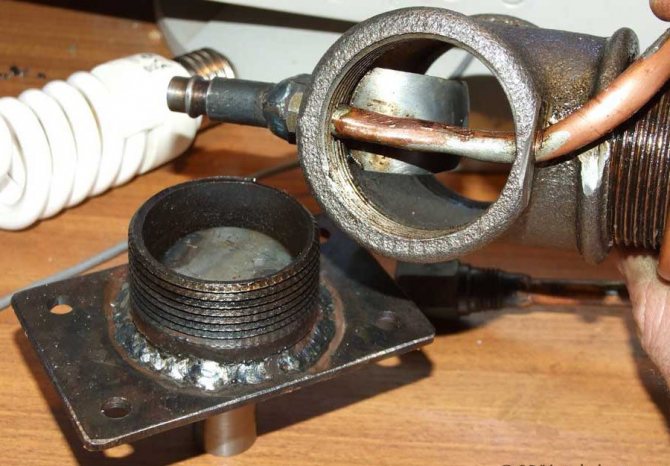

Since it is not possible to warm up the oil first, you need to try to spray it. The simplest burners made according to the Babington scheme can be successfully used in boilers. The design is extremely simple - the fuel flows down a spherical surface. A thin hole is made in the latter, through which compressed air is supplied. It turns out that the oil is blown off the sphere, small droplets are formed, which can be ignited.
Diy Babington burner: drawings and something else
As noted above, the fuel must flow over a curved surface, which is necessary for efficient combustion. However, many people use conventional doorknobs. The first step is to cut off the base; this can be done using a regular hacksaw. Then we solder the copper adapter. Further, a gas or compressed air source is supplied. Pay some attention to cleaning the surfaces. They must be well processed and preferably fat free. Sometimes hollow balls of various diameters made of metal are used in place of the handle. Large diameter balloons are preferred because they provide fast fuel delivery and create a thin film, which is an advantage. In addition, the larger ball has a larger opening. This is important if used oil with a lot of foreign bodies is used. Therefore, if you are faced with a choice between a large and a small ball, then give preference to the first option.
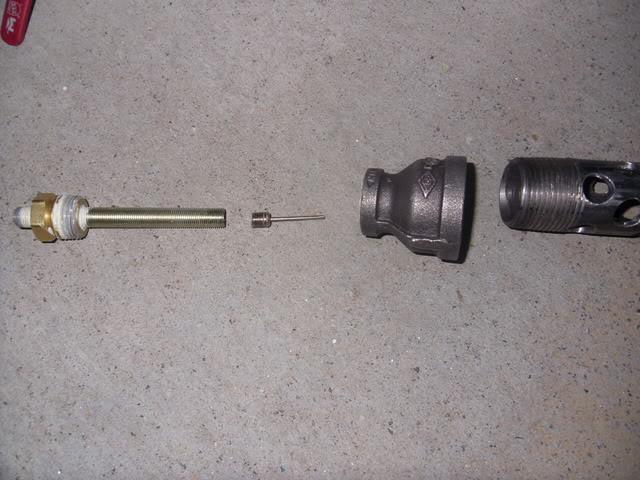

Fuel features
Waste fuel is not only dirty but also very sticky. One of the tasks of engine oil additives is to ensure that they stick with a thin layer of rubbing surfaces operating in difficult conditions. Therefore, the burners during mining work almost exclusively with fuel heating, which increases its fluidity: too viscous fuel does not mix properly with air, does not pass through the nozzle nozzle, or does not cover the spray head with an even layer (see below).
It is also not so easy to set fire to mining: what would it be for engine oil burning in a very hot engine? In fact, only an electric spark and a gas torch are suitable for quick and reliable ignition of a mine. There is, however, one exception, see below.
And third, the mining is contaminated not only with solid particles, but also with water and / or antifreeze that got into it from the internal combustion engine cooling system. Fuel filtration is a complex process. It makes sense to organize it only if fuel testing is constantly available, for example, in a sufficiently large and busy car workshop, and the burner for testing for irregular use should be insensitive not only to solid contaminants, but also to fuel water cut.
Electricity for the burner
Hence, an unfavorable conclusion follows: there are no non-volatile burners during mining.There are ways to burn the mining without pressurization and heating, but such devices (see below) give acceptable technical and environmental indicators only as part of the heat-generating devices developed at the same time and are not burners as such. Therefore, if your power supply is unreliable, and there is enough work off, it would be better to make a furnace or boiler for it.
Full photo and video instructions for making a burner for working out of a blowtorch
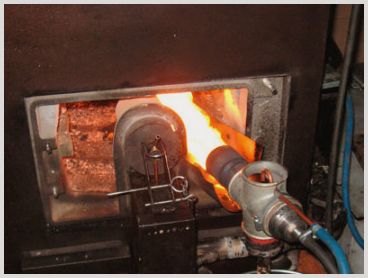

Furnaces and boilers, which are working on mining, have long taken a good place among devices for heating a room. Development is an inexpensive and sometimes free type of fuel, sometimes it is used for this purpose in car services and garages. When choosing a design, many experts ask themselves: is it possible to alter a gasoline lamp for soldering into a burner for testing?
Conversion of industrial burners
It is worth noting that it is much easier to make an oil-based burner from scratch than to alter industrial designs. After all, you still need to invest. For example, when converting a burner for diesel fuel, you will have to spend a lot of money. As a result, the design turns out to be very complicated and it is required to heat the oil. It is much cheaper to buy a ready-made oil burner or make one yourself.


Some people try to make a torch from a blowtorch. But this is not a very good option, since the principle of its operation is very different from what is needed. In the blowtorch, the nozzle heats up and the oil is forced out by the pressure from the nozzle. Gasoline is a refined fuel, which is not the case with used oil. It contains impurities of metals, and combustion products of diesel fuel or gasoline, as well as other types of pollution. As a result, the nozzle clogs up very quickly. You can, of course, modernize it, but the game is not worth it - it is too expensive and labor-intensive. Therefore, it is recommended to give preference to the Babington burner.
Fuel supply and barrel fabrication
We have already figured out a little about how the Babington burner is made. The scheme of the product, despite its simplicity, has several pitfalls. For example, you need to use a suitable pump. Best of all in this case is gear. It is ideal for handling viscous fluids. But if there is no pump, then you can use an elementary scheme for organizing the fuel supply by gravity. But such a solution takes place only if the amount of oil in the sump, and therefore the pressure, is maintained at a high level.
The barrel is a regular metal tube 6 inches in diameter and 3 feet in length. Just one nozzle is enough. If there is a pipe with thick walls, then it is better to use it, since this option is better suited for the combustion process. Pipes of this type retain heat much longer. Do not forget to install a pulsator at the final station. The Babington burner will operate without flame ripple.
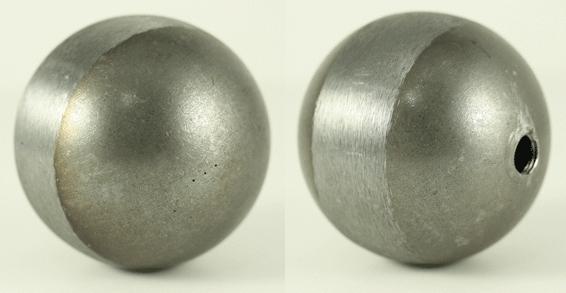

Waste oil types
There are various brands of oils used in one or another industrial or household area of human life. Waste oil has its own characteristics (viscosity, level of contamination and water cut, presence of additives), therefore it can be divided into several groups, depending on the field of application.
Lubricating oils:
- aviation oil;
- motor oil for internal combustion engines;
- autotractor;
- diesel industrial.
Non-lubricating oils:
- technological;
- electrical insulating;
- condenser;
- transformer;
- liquid;
- cable.
Advantages and disadvantages of a do-it-yourself burner
Each technical device has a number of useful qualities and shortcomings. Obviously, this device has more pros than cons. The main advantage is the utilization of waste materials with the greatest benefit. Other advantages of equipment for the disposal of oils and liquid fuels:
- burning mining contributes to the preservation of the environment;
- ease of use and high energy efficiency;
- the manufacture of the device is available in ordinary household conditions;
- obtaining heat at a minimum cost of raw materials;
- a simple scheme for the manufacture of a structure, understandable drawings;
- a homemade device can be made from improvised means;
- use in workshops and at enterprises where a lot of processed raw materials are accumulated that require disposal;
- the small dimensions of the burner allow it to be moved if necessary;
- mining and the lowest-grade oil go to the furnace;
- device functionality;
- relative fire safety;
- reuse of used oil.
The main plus of the burner is the utilization of used oil with benefit.
Disadvantages:
- not recommended for summer cottages and living quarters due to burning and smell;
- the need to equip the premises with a fire extinguisher;
- it is imperative to follow all recommendations for the manufacture of the burner;
- the nozzle or nozzle should be periodically checked (whether the holes are clogged with solid particles);
- sensitivity of the nozzle or nozzle to dirt;
- additional power supply of the components of the device (pump, compressor).
Principle of operation
In most known oil burners, the oil / air mixture is fed through a pressure orifice. In contrast, in the Babington system, oil is supplied by a low-pressure pump and flows freely over a surface that has the shape of a sphere or is close to it. The fuel forms a thin film and evaporates, entrained by a stream of air supplied under pressure into a small (up to 0.3 millimeter) hole in the center of the sphere. Oil vapors and air are mixed to form a torch of the fuel mixture. This torch ignites and heats up what needs to be heated - the walls of the furnace or the liquid heat exchanger of the boiler.
Operating principle
Part of the oil does not have time to evaporate and burn and flows down below the hole, falling into the fuel collection pan. Further, the mining flows from the pallet to the fuel tank and is reused.
To increase the fluidity and volatility of the mining, it is heated. The heated exhaust is sprayed into smaller droplets, which also improves the quality of the fuel mixture and the overall efficiency of the device.
How to make a burner for working off with your own hands?
The idea of using used engine oil as burner fuel is not new. In the world wide web there are many different schemes for the manufacture of such a device. And the demand for this kind of products is only growing. It is clear, because this device will be very useful for household tasks and purposes, heating a summer house or utility room.
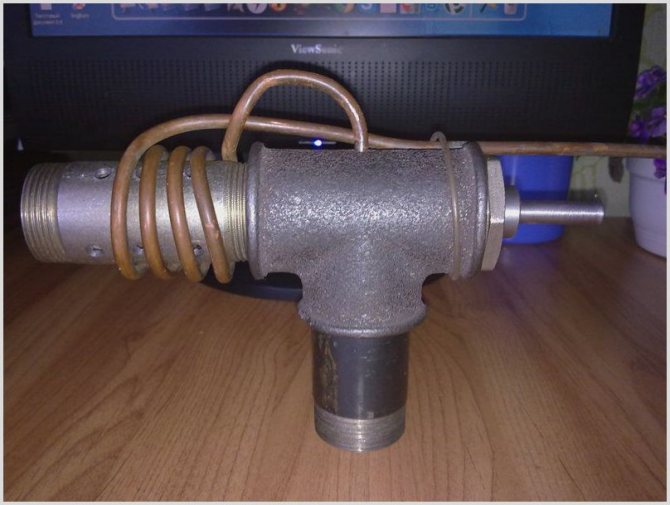

It is also worth saying that it has a large number of advantages:
- Most of the proposed schemes are simple, and every person with a minimum of the necessary abilities and tools is able to assemble it.
- The fuel for such a burner is considered to be quite affordable. It can be found, for the most part, in car repair shops, where there is simply an overabundance of it. Likewise, used oil can be obtained for free or for a small amount.
- Often there is a question with the disposal of used oila, and such a burner can help to process it without harming the external environment.
- This device is multifunctional and can be used as a conventional burner or a heating system on liquid fuel.
- Such a device is generally considered to be mobile., since it weighs a little and dimensions.
- This burner is versatile in terms of the type of fuel used. In essence, it will run on any combustible fuel, whether it is used engine oil, gasoline, kerosene or any other.
Among most schemes, one is considered the most interesting in terms of simplicity, practicality and simplicity. Such a miracle unit is called a Babington burner.It is named after its own creator and its device was impossible for a long time due to the patent. But the time of the patent has expired and now anyone who wants to can implement the scheme.
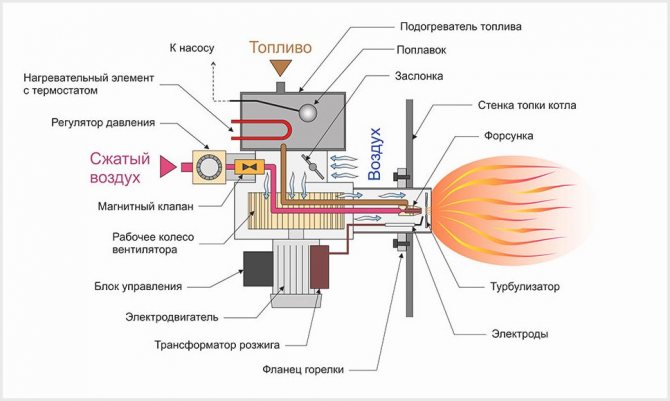

Its working principle is very simple and includes the following stages and parts:
- Pre-heated fuel penetrates the sphere, spreading over it in the same way, organizing a thin film.
- An air blower is connected to the sphere itselfblowing air. A very small hole was made in the area, 0.1-0.3 mm in diameter. Pressurized air escapes from the sphere through this hole. Passing through the fuel, the air scatters it, organizing a kind of aerosol.
- Then this trickle is set on fire and a burning torch comes out.
- The rest of the unused mining flows into the sump and can be reused.
- ForIn order for the unused waste oil to automatically flow back to the sphere, you need to connect a pump to the system, which will supply fuel from the sump.
Preparatory fuel heating solves 2 problems at once:
- Increased fluidity. The heated waste oil spreads better over the surface of the sphere and is more easily atomized by the supplied air.
- Makes torch lighting easier. At the same time, it is not only easier to make, so to speak, start-up of the device, but also the efficiency increases.
The good qualities of such a scheme can be called:
- Multifunctionality in the use of fuel. Such a burner is almost independent of the degree of contamination of the liquid energy carrier.
- No need for filtration. Due to the fact that there are no narrow passages in the system, apart from the air holes, it does not need filtration, unlike factory substitutes.
babington burner.
| Babington burner nozzle fabrication and testing |
| Bubington burner nozzle made and tested |
| Tags: |
| Cheap heat. Waste oil burner (babington). |
| This video shows a real and safe babington burner. The stove heats the room ... |
| Tags: |
| Do-it-yourself Babington burner assembly. Part 1 |
| Part 2: Part 3: Making a sphere: ... |
| Tags: |
| The Babington burner, what happened after three months of continuous operation. |
| In this video, you can see how much soot accumulates in the waste oil boiler after three months of continuous ... |
| Tags: |
| babington burner (complete failure). |
| Here's what happens if you assemble the burner as they say on ... ... smh! YOU MUST CONNECT EARTH TO ... |
| Tags: |
| design and 3D model of a Babington burner |
| A short story about my design and the Babington burner that has been working with me for more than a year and ... |
| Tags: |
| Aqua Breneran and Babington Waste Oil Burner Five Years Later. |
| Aqua Breneran and Babington Waste Oil Burner Five Years Later. |
| Tags: |
| Bubington burner |
| Waste oil babington burner. I have been warming myself with such a construction for the fourth year. I didn't count the power ... |
| Tags: |
| Do-it-yourself Babington burner assembly. Part 2 |
| Part 1: Part 3: Making the sphere: ... |
| Tags: |
| Do-it-yourself Babington burner assembly. Part 3 |
| Part 1: Part 2: Making the sphere: ... |
| Tags: |
| Burner Babington |
| Consumption from 1 to 3 liters. It can be installed automatically in any boiler. The tank burns without smoke. |
| Tags: |
| Burner Babington Part 4 (Ultrafine atomization) |
| I am testing a modernized ball of a Babington burner, 4 holes, air consumption at 3 atm 125-137 cm³ / min. |
| Tags: |
| automatic babington burner |
| installation of a nozzle from a diesel burner as a ball, use of automation from a diesel burner ... |
| Tags: |
| babington burner 1 |
| babington burner. |
| Tags: |
| what the burner consists of, a burner for working out from the inside (babington) |
| Single Board Delphi DS150E from Video I used to have a Dual Board Adapter ... |
| Tags: |
| Waste oil burner |
| The burner is being worked off. |
| Tags: |
| Burner for working off 14 kW |
| Burner for working off power 14 kW consumption 2-2.5 liters +380689211743 Viber +380950113209 Watsapp +380980253828 ... |
| Tags: |
| Burner restyling |
| New version of the burner. |
| Tags: |
| SHOCK! Review of the burner for working out GNOM from the Stavpech company! |
| Make an order or learn more 8-800-511-30-76 THERE IS A DELIVERY TO ARMENIA. The call within Russia is free. SITE http ... |
| Tags: |
| Waste burner (evaporator). Device and setup |
|
| Tags: |
| Drip burner on any waste oil |
| Drip burner on any waste oil. Drip burner Novo Atlas m2 - manual drip ... |
| Tags: |
| Burner oil consumption for working off from Medved by and Eugene. |
| Waste oil burner. |
| Tags: |
| Babington burner: nuances of design and work |
| One of the first videos filmed with the calculator. If you want to help financially, you can list any ... |
| Tags: |
| Burner Babington Part 2 (drip) |
| Click to view | Manufacturing ball for Babington burner. In this part, I am making a dropper - an important part of the ball ... |
| Tags: |
| The Babington burner at its best. |
| This is the same burner, only with a lower pump capacity. Obviously, the result is close to theory…. |
| Tags: |
| Do-it-yourself Babington burner. Overview |
| Review of Babington's homemade burner. The burner is built into a 27 kW solid fuel boiler and is used ... |
| Tags: |
| This is how Real Babington burns. |
| There is a lot of comments on the Internet in the video about the Babington burners forged on a whim - they say - weigh ... |
| Tags: |
| Babington burner. Design revision |
| Accessories for the assembly of a babington burner. |
| Tags: |
| Homemade babington burner. Part 1 |
| This program and configuration has been tested on several burners and only proved to be better ... |
| Tags: |
| Bubington burner controller on Arduino "rel =" spf-prefetch |
Security measures
- A burner fueled with oils and other GSP can be dangerous if installed and used incorrectly; in order to avoid a fire, a number of measures must be followed:
- floors and walls made of combustible materials are sheathed with metal or asbestos sheets;
- the fuel supply is stored at a safe distance;
- oil drips must be removed in a timely manner;
- the electrical components of the unit must be carefully insulated to avoid sparking in the oil spray area;
- the burner must be located out of reach of air currents and drafts.
A burner with an open nozzle must not be left running unattended!
The Babington burner, in contrast to the blowtorch converted for mining, is a reliable and durable unit that does not require complex maintenance. It is enough to periodically clean the fuel system, tank and sump, blow the air duct in idle mode, and also monitor the compressor and oil pump. A working burner is a reliable and economical unit with a long service life.
About reworking a blowtorch for working off
Some home craftsmen, having studied the principle of operation of the Babington burner, are trying to remake an ordinary blowtorch for burning waste oil. The goal is to reduce the cost and simplify manufacturing, because the processes in these two devices are supposedly similar.This opinion is erroneous, since the blowtorch functions differently than the homemade torch described here.
In the lamp, air is pumped into the tank with gasoline for one purpose - to push it out and feed it to the nozzle. In this case, the fuel goes through the stage of heating and evaporation. The nozzle delivers gasoline vapors to the combustion zone, the liquid can be observed there only at the stage of ignition, when the "head" of the blowtorch has not yet warmed up. The used oil cannot be evaporated and the nozzle will supply it in the form of large drops, which does not contribute to normal combustion. And the cross-section of the jet will quickly clog up from various impurities.
The conclusion is simple: it will not be possible to remake a blowtorch for burning heavy liquid fuel.
Advantages and disadvantages of a liquid fuel burner


This equipment has a lot of advantages, the main of which are:
- Ease of DIY manufacturing and operation.
- Widespread distribution of drawings for the manufacture of devices.
- The cheapness of waste oil used as fuel.
- These devices are perfect for transport organizations and companies where there is a lot of testing. Thus, it is possible to dispose of the waste and heat the premises.
- Efficiency and functionality of devices.
- Device mobility.
Despite the listed advantages, the burner also has a disadvantage. It is quite demanding on the quality of the used oil.
Is it possible to make a soldering lamp work on working off?


The working principle of a conventional blowtorch is to ignite gasoline vapors, which are pushed outward by compressed air. This effect is achieved by forcing air into the burner fuel tank.
What happens if you pour waste oil into the soldering lamp?
The oil itself, even under pressure, erodes badly - it must be heated. Poor atomization will cause uneven flames and it will not be easy to ignite the burner. The oil burns with the formation of a significant amount of soot and soot, thanks to which the jet will quickly coke, its cross-section will become smaller, and the lamp will break. An increase in the nozzle section will also not give the expected effect - the oil will be sprayed in large drops, which will not make it possible to obtain the same torch flame.
Moreover, used oil often contains impurities: diesel fuel, gasoline, antifreeze and even water, which can lead to flashes in the middle of the lamp. To use the test as fuel for a blowtorch, you will have to arrange a filtration system, this will further complicate the task.
Taking into account all the difficulties, it is difficult and unsafe to use a gasoline lamp for soldering as a burner for working off. Due to this, it is necessary to modify or completely change its design.
Nozzle
First, you need to make a spherical injector, fuel will flow through it in the future. Make a hole in the sphere, the diameter should be about 0.25 mm
Please note that the power of a homemade burner depends on the diameter. The smaller the diameter, the lower the power and vice versa
All the difficulties await you in the manufacture of the nozzle. The air passage must be perfectly flat. It is necessary that the air blows forward, and not along the walls of the nozzle. The best option is to make a hole on a special machine.


But if you are lucky and you find a jet with the desired diameter, then do not miss the opportunity and place it in the center of the spherical element. If you don't find a hemisphere, you can use a small piece of sheet metal with a jet attached inside. The result is an oil spray nozzle. Heated fuel will enter it, and atomization occurs due to the incoming air. By installing such a device in a universal boiler, you get an efficient and cheap heat source.
Features of making do-it-yourself liquid fuel burners
Burner Babington
Its inner dimension is one inch and the wall is quite thick. The lower section is necessary for supplying the oil-air suspension to the compartment, where combustion takes place. The upper section is used as the torch socket. A torch of flame with a high temperature is emitted from it. A simple household vacuum cleaner with high power is used to provide a flow of air that is forced into the oven to form a torch.
Making a burner with your own hands is quite simple. To do this, you will need a welding machine with which the parts are connected, as well as a grinder and a lathe.
Manufacturing begins with the body. To do this, you need to find an empty gas cylinder of a suitable size. Then remove the filler hole and use the template to mark the pipe fasteners. Then with an electric drill, drill them along the inner part of the contour. To do this, you must use a drill in the form of a spiral. With a high degree of accuracy, using a chisel or grinder, you need to remove the jumpers between the holes. In order for the holes for the seating of the pipes to be of the correct shape, it is necessary to bore them with a round file by hand. You can also do this with a cutter by placing it in an electric drill. When working with metal, you must follow the safety regulations.
Pipes are inserted into the holes of the desired size and welded. Pipes are measured in advance and sawn off with a grinder. A hole is made in the lower half of the pipe and an M16 nut is welded. This hole is required for attaching the oil nozzle.
The principle of feeding mining into the burner itself
The oil nozzle is made on a lathe. A rod is used for the base, which has a smooth shank. It is required when attaching the oil supply hose. If a flexible liner is provided, then it is necessary to cut a thread on this part. For most of the length of the rod, metric threads are made. The pipe diameter is 16 mm. A hole is drilled through almost the entire length of the nozzle. It meets with a transverse piece installed at the bottom, the diameter of which is 3 mm. If you own turning skills, then this part is easy to do with your own hands. And if not, then you can order it from a professional.
The principle of operation of the nozzle is based on the drainage of the working out of a viscous consistency from the hole, which is drilled in the transverse part, and its capture by the air flow. This process breaks the fuel into small droplets. Their combustion is much easier.
Air flow regulation
Making a furnace for testing
The strength of the fiery torch depends on the intensity of the air flow. The adjustment system is based on a steel cup. It has a semicircular bottom and a hole of a certain diameter. This fairly simple part can also be made on a lathe. For the exact execution of the bottom in the form of a hemisphere, it is necessary to use cutters, and, of course, it must be made by her turner with high qualifications.
The air flow is regulated by a round curtain. It is fixed on the L-shaped axis with an M4 screw.
For a firm connection of the outlet pipe, on which the hose is put on, and the operation of the air valve, an adapter is used, which has a slot along its length.
During arson, access to the mining chamber is provided by a cover with a sufficiently large weight. It is installed on pre-welded canopies on the neck of the body. If the part is used not such a massive part, then spontaneous opening of the device during operation is possible. If all the steps during the assembly of the burner were performed correctly, then its operation is accompanied by an even flame of violet color, which occurs when the oil-air mixture burns in the body of the device.
When working with a liquid fuel burner, the fire safety regulations must be observed. The attachment point of the nozzle itself and the hose through which the fuel in liquid form enters must be protected with a steel screen. It will protect the used oil from ignition in case of leakage.
How the air is adjusted
The strength of the fire will depend on the calculation of the strength of the air flow.
The heart of the system is to adjust a steel cup or ball that has holes of the desired diameter and a semicircular bottom.
This is also done with a lathe. To create the correct hemisphere, cutters are used. It is attached to the L-shaped axis with an M4 screw.
When ignition occurs, a heavy cover provides access to the treatment chamber. It is installed on welded canopies to the neck of the body. When the weight is not heavy, an involuntary opening may occur. If all parts of the assembly are made correctly, then during operation a violet flame is issued with an even background, appearing from the combustion of the air-oil mixture inside the device.
This burner is quite easy to manufacture, however, you should carefully consider the safety rules during operation and further use. It is important to know that you should be especially careful when choosing a cylinder to create a device body. The cylinder is required to be empty, otherwise, when holes are made, it can cause severe injury.
Watch a video in which a specialist explains in detail how to make a Babington burner with your own hands:
Source: teplo.guru
Of course, it is impossible to operate the burner in this form, it is necessary to build automation.
I decided to make the device completely autonomous, so that it starts and turns off itself when needed by the commands of the thermostat. In general, the idea was to take the burner outside and heat it with an ordinary gas boiler, and put pipes into the garage and hang radiators, filling the system with antifreeze. For safety, if anything happens, let it burn on the street away from buildings
